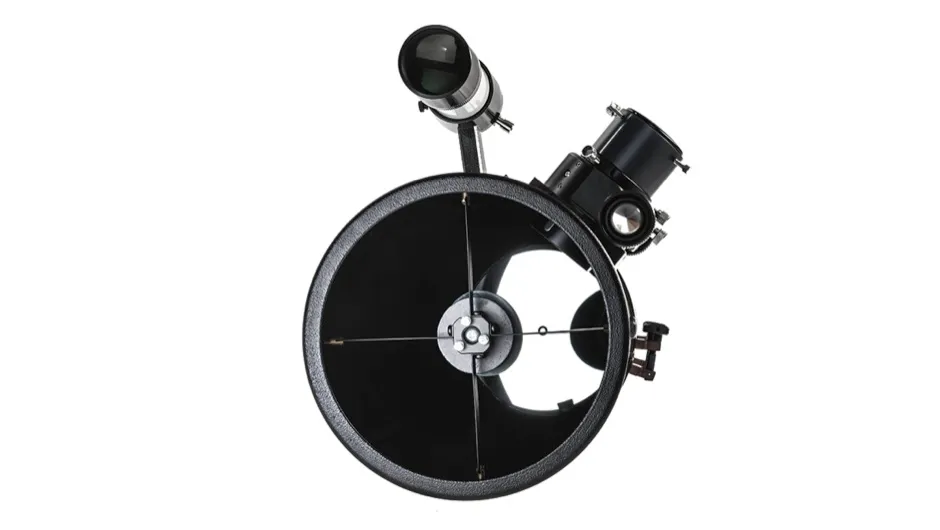Orion Optics' VX series is aimed at those who want a quality, easy to use telescope.A range of apertures is available, from 6 to 20 inches, as are short or long focal ratios.
The VX8 is an affordable yet lightweight system, and without accessories weighs just 7kg.
It is constructed from a rolled aluminium tube finished in white with black trim and is supplied with tube rings and mounting bar.
A straight-through 8x50 finderscope, ACU-2S 2-inch (50.8mm) Crayford focuser with a 1.25- to 2-inch adaptor and a cooling fan at the base completes the package.
When ordering you have the choice to upgrade the optics and add a mount, but our review is just of the basic telescope tube, which we found easy to attach to our own NEQ6 mount and quickly achieved balance.
Using our own 25mm 1.25-inch eyepiece we aimed at the bright star Altair in Aquila, but initial testing showed the optics had slipped a little in collimation.
Dropping in a webcam and defocusing to produce an Airy disc, we found that its concentric rings were offset to one side.
The primary mirror is supported by a nine-point cell with easy collimation and, after a few simple adjustments, we quickly had Altair pin sharp across 80 per cent of the view.
At the edges there was a little coma where the stars take on the shape of a comet (hence ‘coma’) but this is to be expected in ‘fast’ systems with their shorter focal lengths.

Base appeal
With our 25mm eyepiece we found the slight effect of coma didn’t greatly detract from our view of the Pleiades as it rose in the east, and the cluster was nicely framed with a hint of the Merope nebulosity visible.
Turning to the Double Cluster in Perseus was equally rewarding. Swapping to a 10mm eyepiece, we homed in on the Dumbbell Nebula, M27 in Vulpecula.
The nebula was bright and detailed whilst nearby M57, the Ring Nebula in Lyra, displayed a dark hollow reminiscent of its name.
The galaxy pair of M81 and M82 over in Ursa Major were not ideally placed, but still glowed nicely in both our 25mm and 10mm eyepieces.
To test the scope’s resolving power we used our 10mm eyepiece to view the stunning double star Albireo in Cygnus, and were not disappointed with its gold and blue components.
However a better test was Iota Cassiopeiae. This is a tight triple star – we were able to split it using our 25mm eyepiece and a 5x Powermate lens, but it does need good seeing conditions.
It is worth noting that we could not split Iota Cassiopeiae until we had recollimated the scope, proving how important good collimation is.
Our final deep-sky target was globular cluster M13 in Hercules and on increasing the magnification we were delighted to see swarms of stars and the dark Propeller feature.
There were no bright planets to view, but the Moon was crisp and full of detail at a range of magnifications with nice features viewed along the terminator.
Attaching our Canon EOS 300D and 50D DSLRs with our own adaptors we imaged several deep-sky objects, including the Double Cluster, the Dumbbell Nebula and M13 with very satisfying results.
Our shots of the Double Cluster and Dumbbell Nebula were taken before we noticed the collimation was out (we had hurried to take advantage of a spell of clear weather) and the effects of the coma are more exaggerated compared with the image we took of M13 a few nights later, after we had performed our visual tests and recollimated.
The Moon also proved a worthwhile target, showing lots of detail. In short, this is a nice telescope to get you started with both visual observing and imaging.
Finder
The 8x50 straight-through finderscope gave good performance and clear views of the stars and brighter deep-sky targets. On ordering there is an option to upgrade to a right-angled finder.
Lightweight body
The rolled aluminium tube weighs 7kg and is only 86cm long, and as such we found it very easy to lift and attach to our chosen mount via the tube rings and dovetail bar. This means it can also be easily mounted on simple altaz mounts.
Focuser
The dual-speed ACU-2S 2-inch Crayford focuser has an extension that allows eyepieces to reach focus, and this can be removed for prime focus astrophotography. It gave very fine focusing control and can be tensioned or locked in position via a screw at the base.
Optics
The optical configuration is a paraboloid primary mirror at the rear with a flat secondary mirror at the front. They are made of low-expansion Suprax glass from Schott and the primary comes with a Zygo report detailing its optical quality.
Collimation
The primary mirror is housed in a nine-point suspension cell, giving a high degree of recollimation capability if required. The cell is also fitted with a fan to help cool the mirror to the local ambient temperature, thereby reducing air currents in the tube that might spoil the view.
Vital stats
- Price £528 plus VAT
- Optics Paraboloid primary mirror and flat secondary
- Aperture 200mm (8 inches)
- Focal Length 900mm (f/4.5)
- Weight 7kg (tube only)
- Focuser ACU-2S 2-inch Crayford focuser
- Extras 8x50 straight-through finderscope, tube rings, Vixen-style mounting bar
- Supplier Orion Optics
- Telephone 01782 614200
- www.orionoptics.co.uk

